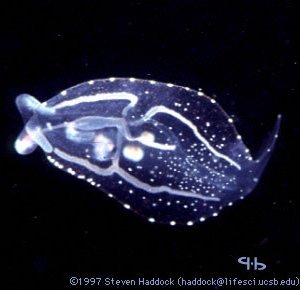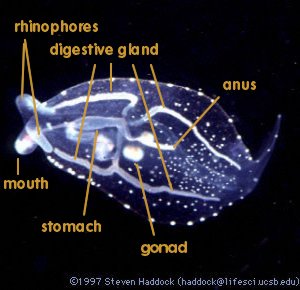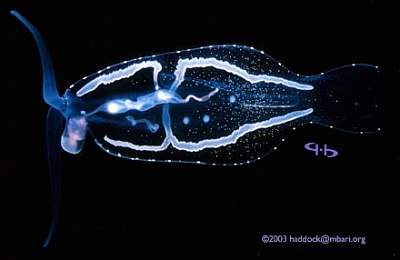

Phylliroe bucephalum
Peron & Lesueur, 1810
Order: NUDIBRANCHIA
Suborder: DENDRONOTINA
Family: Phylliroidae
DISTRIBUTION
Planktonic nudibranchs apparently found throughout the world
PHOTO
Left lateral view of animal, approx 8 cm long. Photo: Steve Haddock. Lower photo, modified and labelled by Bill Rudman.
See Steve's Bioluminescence Site: http://lifesci.ucsb.edu/~biolum/
Highly modified planktonic nudibranch. The juveniles have been reported to parasitise the medusae of the cnidarian Zanclea, attaching to the inside of the bell, on which they feed and remain until adulthood. As adults they are free-living, feeding on Zanclea as well as other medusae and plankton, including Oikopleura. Their basic anatomy can be seen through their transparent body wall. The two dorsal lobes of the digestive gland are modified into two dorsal tubular structures, and the posterior lobe becomes two ventral tubular lobes. The short intestine lead to the anus which opens midway down the right side of the body. Phylliroe is one of the few nudibranchs to exhibit bioluminescence.
Two mispellings of the generic name: Phyllirhoe Oken, 1815 and Phyllirrhoe Menke, 1821 entered the literature very early on and unfortunately are still used today.
Reference:
• Lalli, C.M. & Gilmer, R.W. (1989). Pelagic Snails. The biology of holoplanktonic gastropod mollusks. Stanford: Stanford University Press.
Rudman, W.B., 2000 (August 9) Phylliroe bucephalum Peron & Lesueur, 1810. [In] Sea Slug Forum. Australian Museum, Sydney. Available from http://www.seaslugforum.net/find/phyllir
Related messages
Another Phylliroe photo
March 18, 2003
From: Steve Haddock

Hi Bill,
To join my earlier photo, I have a new and improved Phylliroe picture for you.
This shot is much clearer and easier to understand than the previous one. The specimen was collected on a blue-water dive at about 15m at 31°29N by 134°51W -- somewhere between California and Hawaii.
We have some exciting new pelagic seaslug info to share - once we get time to write it up!!!
Steve
http://lifesci.ucsb.edu/~biolum
http://lifesci.ucsb.edu/~haddock
Thanks Steve,
I look forward to hearing about your other finds in the not too distant future
Cheers,
Bill Rudman
Bioluminescence in Phylliroe
August 10, 2000
From: Steven Haddock

Hi Bill.
First of all, the SeaSlug Forum is really incredible. The illustrations are simply amazing!
I wondered if you were still interested in photos of Phyllirhoe? I have an OK, but not great one as part of my bioluminescence site: http://lifesci.ucsb.edu/~biolum/, which I am happy for you to use.
In the photo, the head is on the left. The animal is approximately 8 cm long.
Best wishes,
Steve
biolum@lifesci.ucsb.edu
Haddock, S., 2000 (Aug 10) Bioluminescence in Phylliroe. [Message in] Sea Slug Forum. Australian Museum, Sydney. Available from http://www.seaslugforum.net/find/2860Dear Steve,
I see I posted my request for a photo in 1998. Its a bit like trying to collect a particular nudibranch - sometimes it takes a while, but it's worth it in the end. Thanks for the offer which I gratefully accept. I wish you well with your bioluminescence site. It already has some fascinating information and photos on it. I would dearly love to photograph Plocamopherus imperialis or one of the other species of Plocamopherus which seem to be the best examples of bioluminescence amongst the benthic nudibranchs, but it only seems to light up on rare occasions, and the few times I have seen it in action I didn't have my camera ready.
Your photo has given me the energy to add some information on this fascinating animal to the Phylliroe bucephalum Page.
Best wishes,
Bill Rudman.
Phylliroe
November 18, 1998
From: Clay Bryce
Bill,
Do you have anything on this genus? I am seeking a photo / diag. of anything that even looks like it - even a Heteropod as it may just be one of these. My specimen and photo(out of focus) is from east Pacific. Tough call, I realise, but I have such faith in your abilities!
Cheers,
Clay
Clay Bryce
Western Australian Museum
Perth
brycec@museum.wa.gov.au
Bryce, C., 1998 (Nov 18) Phylliroe. [Message in] Sea Slug Forum. Australian Museum, Sydney. Available from http://www.seaslugforum.net/find/312Dear Clay,
I'm afraid flattery won't work this time. I haven't got a photo of Phylliroe.
There is a drawing in the new mollusc book "Mollusca: the southern synthesis". Your best bet is the wonderful book:
Lalli, C.M. & Gilmer, R.W. (1989). Pelagic Snails. The biology of holoplanktonic gastropod mollusks. Stanford: Stanford University Press.
It has illustrations and photos of living animals of groups of planktonic molluscs, including species of Phylliroe.
Bill
Rudman, W.B., 1998 (Nov 18). Comment on Phylliroe by Clay Bryce. [Message in] Sea Slug Forum. Australian Museum, Sydney. Available from http://www.seaslugforum.net/find/312